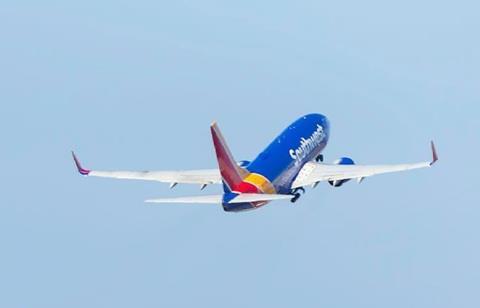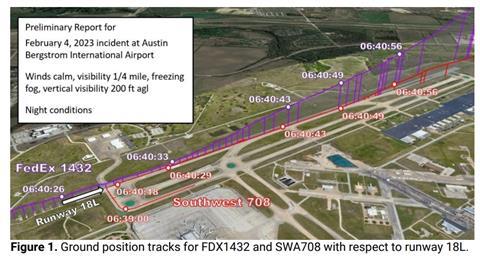The US National Transportation Safety Board (NTSB) has issued a preliminary report of a near-miss involving a FedEx Boeing 767-300ER and a Southwest Airlines 737 in Austin last month.
On 4 February, a FedEx aircraft descended toward an active runway before breaking off its approach due to departing traffic on the same runway, the Federal Aviation Administration (FAA) and flight data from FlightAware showed. At the time, data estimated the distance between the aircraft was less than 200ft.
The US safety agency says in its report, published on 2 March, that the incident involved an “overflight that resulted in a loss of separation” between the two aircraft, but “the closest proximity has not yet been determined”.

The incident took place early in the morning, when, according to air traffic control, “there was an extremely low traffic volume and complexity” at Austin Bergstrom International airport. The weather at the time was “low instrument flight rules”, meaning both aircraft had limited horizontal and vertical visibility.
The incident involved FedEx flight 1432, a 767 (N297FE), and Southwest flight 708, a 737-700 (N7827A). The FedEx jet took off from Memphis that morning at about 06:21 Eastern US time and flew the roughly 486nm (900km) to Memphis, flight tracking data shows. The Southwest aircraft was bound for Cancun.
At about 06:40 Central US time, when the FedEx freighter was “several miles from” Austin’s airport, controllers cleared its pilots to land on Austin’s runway 18L. The Southwest aircraft was cleared for take-off on the same runway.
“According to the captain of FDX1432, he noted that, at an altitude of about 150ft, the [first officer] called go-around after visually seeing SWA708 at approximately 1,000ft to 1,500ft from the approach end of the runway,” the NTSB says. “At 06:40:34, one of the FDX1432 crew broadcasted ‘Southwest abort’, and then at 06:40:37 broadcasted that ‘FedEx is on the go.’”
The NTSB says that a preliminary review of Automatic Dependent Surveillance-Broadcast data revealed that ”when FDX1432 was at the departure end of the runway climbing out of 1,900ft, the controller instructed FDX1432 to turn left on heading 080 and maintain 3,000ft. At the same time, SWA708 was about 1,000ft lower than FDX1432 and began a right turn away from the runway heading.”
After performing the go-around, the FedEx aircraft landed uneventfully and the Southwest aircraft flew its scheduled route to Cancun.
The NTSB interviewed pilots, air traffic control personnel and a weather office supervisor.
“The digital flight-data recorders were removed from both airplanes and shipped to the NTSB’s Vehicle Recorder Laboratory located in Washington, DC. Both… have been downloaded, and the data is currently being analysed,” NTSB says,
“The cockpit-voice recorders were overwritten,” it adds.

There were no injuries reported to the 128 passengers and crew aboard the Southwest jet or to the three crew on the FedEx aircraft, NTSB says.
The incident is one of numerous serious similar air traffic control events since the beginning of the year. On 13 January at New York’s John F Kennedy International airport, a Delta Air Lines 737 aborted its take-off after an American Airlines 777 was crossing the same runway. Most recently, on 27 February in Boston, a JetBlue Airways Embraer 190 and a Learjet operated by charter company Hop-A-Jet had a close call at a runway intersection.
In response to recent events, FAA acting administrator Billy Nolen told lawmakers in Washington DC on 28 February that his agency was launching a safety review.
“Because I want to make sure we are giving the right attention to all of these recent occurrences, I have formed the safety review team to examine the US aerospace system’s structure, culture, processes, systems and integration of safety,” he said.


























